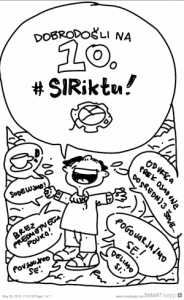Manca Griljc, Osnovna šola Marije Vere, Kamnik
Three-dimensional (3D) modelling is a modern approach to art education and teaching. Pupils get basic knowledge for further education, which is a prospective area. They also obtain basic knowledge about digital sculpturing and develop further knowledge themselves; they co-create learning process and actively participate in teaching and, thus, develop their skills in leading and cooperation. In the workshop, we create a digital sculpture using programme Sculptris and discuss the advantages and disadvantages of such modern lessons. The objective of the workshop is to present digital sculpturing which is the basic of 3D modelling and can be used in art education, history, geography, chemistry, mathematics along with orienting pupils as well as participants to areas that are actual and prospective in technology, development and labour market. Differences between traditional and digital sculpturing open dilemmas about the choice of teaching method and procedure. Physical form on one side and digital one on the other that also obtains a physical form with 3D printing as well as physical tools contra digital tools are obvious. Adding and removing material – where are advantages and disadvantages? In traditional sculpturing, we have one final product while digital sculpturing enables partial savings and thus more variations. In the traditional sculpturing, we see the product all the time while in digital sculpturing we see the product at the end of the process. Which approach shall be presented to pupils? In which process pupils are more actively included in the learning and teaching process, where is motivation stronger? Even if digital sculpturing offers possibilities that facilitate workflow during process, the artistic value of artistic products should be considered since it is the basic spot of art. A creation made by human hands with all sensibility and sensuality, can hardly be replaced by a computer-designed and industrial product. Thus, does traditional sculpturing create better artist or vice versa? Is a good artist formed by creativity or by choice of tools? Are digitally modelled pieces of art too perfect and do human errors (uneven texture, asymmetry) make a fine art product an artistic product? Is digital sculpturing a step forward or backward in fine arts?
